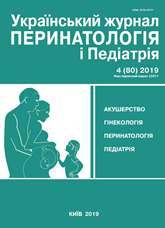The interaction of risk factors for early pregnancy loss in conditions of natural iodine deficiency
DOI:
https://doi.org/10.15574/PP.2019.80.4Keywords:
early pregnancy loss, iodine deficiency, prediction algorithmAbstract
A methodology for assessing the prognostic value of various risk factors for early pregnancy loss (EPL) in women with altered parameters of iodine-thyroid homeostasis (ITH), permanently living in an endemic zone is presented.Purpose — to determine the prognostic value of EPL risk factors and to study their interaction in early spontaneous abortion in women with ITH disorders.
Patients and methods. The study involved 77 women living in conditions of natural iodine deficiency (47 women with spontaneous abortion in the first trimester and 30 women with full-term pregnancy). High informational content was established for 9 clinical and laboratory parameters, of which 4 (ioduria, TSH, the level of free thyroxine and the titer of TPO-ab) characterized the condition of EPL. By applying Wald's sequential analysis with an assessment of the information content of signs, a logistic model to predict the EPL is constructed.
Results. The altered parameters of ITH due to both iodine deficiency and the autoimmune component are associated with an increase in the incidence of EPL. Their independent prognostic value is realized only at an iodine excretion level <49 μg/L. Accordingly, at ioduria levels corresponding to a mild degree of iodine deficiency, or the absence thereof, the independent prognostic value of ITH parameters is not statistically significant and is realized only in combination with other risk factors. This necessitates a comprehensive pre-conceptual study of ITH parameters in assessing the risk of EPL in order to achieve an euthyroid condition by the time of pregnancy. A method for differentiated assessment EPL risk both with regard to the role of individual factors and their influence in the aggregate, namely the interaction of thyroid and nonthyroid risk factors.
Conclusions. The presented logistic model and the methodology for its interpretation showed the high significance of ITH parameters for predicting the risk of EPL.
The research was carried out in accordance with the principles of the Helsinki Declaration. The study protocol was approved by the Local Ethics Committee of SU «Uzhhorod National University». The informed consent of the patient was obtained for conducting the studies.
No conflict of interest were declared by the authors. No conflict of interest were declared by the authors.
References
Antipkin YuG, Davyidova YuV. (2012). Osnovnyie napravleniya razvitiya perinatalnoy meditsinyi. Reproduktiv. endokrinologiya. 2: 5–7.
Herzanych SO. (2008). Antytila do tyroperoksydazy i funktsiia shchytovydnoi zalozy u vahitnykh v umovakh pryrodnoho yodnoho defitsytu. Pediatriia, akusherstvo ta hinekolohiia. 4: 42–49.
Herzanych SO. (2008). Antytila do tyroperoksydazy i funktsiia shchytovydnoi zalozy u vahitnykh v umovakh pryrodnoho yodnoho defitsytu. Pediatriia, akusherstvo ta hinekolohiia. 6: 74–77.
Herzanych SO, Zadorozhna TD, Dashkevych VIe. (2011). Morfolohichna ta imunohistokhimichna kharakterystyka platsent zhinok iz riznym yodnym zabezpechenniam pid chas vahitnosti. Zdorove zhenschinyi. 6 (62): 90–94.
Gubler EV. (1990). Informatika v patologii, klinicheskoy meditsine i pediatrii. Leningrad: Meditsina: 176.
Dashkevych VIe, Herzanych SO, Bulyk LM. (2007). Funktsionalnyi stan shchytovydnoi zalozy pry nevynoshuvanni vahitnosti v umovakh riznoi yodnoi zabezpechenosti. Reproduktivnoe zdorove zhenschinyi. 2: 84–87.
Zhabchenko IA. (2018). Habitual miscarriage: what you should do and what you should not do (Review). Health of woman. 1 (127): 9–14. doi 10.15574/HW.2018.127.9
Arias-Sosa LA, Acosta ID, Lucena-Quevedo E, Moreno-Ortiz H., Esteban-Perez C, Forero-Castro M. (2018). Genetic and epigenetic variations associated with idiopathic recurrent pregnancy loss. J Assist Reprod Genet. 35 (3): 355–366. https://doi.org/10.1007/s10815-017-1108-y; PMid:29313278 PMCid:PMC5904072
Glinoer D. (2007). The importance of iodine nutrition during pregnancy. Public Health Nutr. 12 (10): 1542–1546. https://doi.org/10.1017/S1368980007360886; PMid:18053277
Van der Haar F, Gerasimov G, Tyler VQ, Timmer A. (2011). Universal salt iodization in the Central and Eastern Europe, Commonwealth of Independent States (CEE/CIS) Region during the decade 2000–09: Experiences, achievements, and lessons learned. Food and Nutrition Bulletin. 4 (32) (supplement). United Nations University Press: 294. https://doi.org/10.1177/15648265110324S401; PMid:22416358
Haixia Liu, Zhongyan Shan, Chenyan Li, Jinyuan Mao. (2014). Maternal subclinical hypothyroidism, thyroid autoimmunity, and the risk of miscarriage: a prospective cohort study. Thyroid. 24 (11): 1642–1649. https://doi.org/10.1089/thy.2014.0029; PMid:25087688 PMCid:PMC4229690
Hui He, Shuang Jing, Fei Gong, Yue Qiu Tan, Guang Xiu Lu, Ge Lin. (2016). Effect of thyroid autoimmunity per se on assisted reproduction treatment outcomes: A meta-analysis. Taiw J Obstet Ginecol. 55 (2): 159–165. https://doi.org/10.1016/j.tjog.2015.09.003; PMid:27125395
Negro R, Formoso G, Mangieri T, Pezzarossa A, Dazzi D, Hassan H. (2006). Levothyroxine treatment in euthyroid pregnant women with autoimmune thyroid disease: effects on obstetrical complications. J Clin Endocrinol Metab. 91 (7): 2587–25891. https://doi.org/10.1210/jc.2005-1603; PMid:16621910
Prummel MF, Wiersinga WM. (2004). Thyroid autoimmunity and miscarriage. Eur J Endocrinol. 150 (6): 751–755. https://doi.org/10.1530/eje.0.1500751; PMid:15191343
Stagnaro-Green A. (2011). Thyroid antibodies and miscarriage: where are we at a generation later? J Thyroid Res. 2011: 8419–8449. https://doi.org/10.4061/2011/841949; PMid:21687610 PMCid:PMC3112530
Thangaratinam Sh, Tan A, Knox E, Kilby MD, Franklyn J, Coomarasamy A. (2011). Association between thyroid autoantibodies and miscarriage and preterm birth: metaanalysis of evidence. Br Med J. 342 (7806): d2616. https://doi.org/10.1136/bmj.d2616; PMid:21558126 PMCid:PMC3089879
Downloads
Issue
Section
License
The policy of the Journal “Ukrainian Journal of Perinatology and Pediatrics” is compatible with the vast majority of funders' of open access and self-archiving policies. The journal provides immediate open access route being convinced that everyone – not only scientists - can benefit from research results, and publishes articles exclusively under open access distribution, with a Creative Commons Attribution-Noncommercial 4.0 international license(СС BY-NC).
Authors transfer the copyright to the Journal “MODERN PEDIATRICS. UKRAINE” when the manuscript is accepted for publication. Authors declare that this manuscript has not been published nor is under simultaneous consideration for publication elsewhere. After publication, the articles become freely available on-line to the public.
Readers have the right to use, distribute, and reproduce articles in any medium, provided the articles and the journal are properly cited.
The use of published materials for commercial purposes is strongly prohibited.

